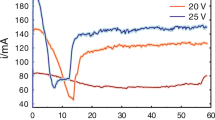Abstract
Attainment of the greatest possible interior surface smoothness is critical to meeting the performance demands placed upon niobium superconducting radiofrequency (SRF) accelerator cavities by next generation projects. Electropolishing with HF–H2SO4 electrolytes yields cavities that meet SRF performance goals, but a less-hazardous, more environmentally-friendly process is desirable. Reported studies of EP on chemically-similar tantalum describe the use of sulfuric acid–methanol electrolytes as an HF-free alternative. Reported here are the results of experiments on niobium samples with this electrolyte. Voltammetry experiments indicate a current plateau whose voltage range expands with increasing acid concentration and decreasing temperature. Impedance spectroscopy indicates that a compact salt film is responsible for the current plateau. Equivalent findings in electropolishing chemically-similar tantalum with this electrolyte were interpreted due to as mass transfer limitation by diffusion of Ta ions away from the anode surface. We infer that a similar mechanism is at work here. Conditions were found that yield leveling and brightening comparable to that obtained with HF–H2SO4 mixtures.







Similar content being viewed by others
References
Padamsee H, Knobloch J, Hays T (2008) RF superconductivity for accelerators, 2nd edn. Wiley, New York
Padamsee H (2009) RF superconductivity: science, technology and applications. Wiley, Weinheim
Knobloch J, Geng RL, Liepe M, Padamsee H (1999) In: Proc. 9th workshop on RF superconductivity, Ithaca
Saito K (2003) SRF2003 http://srf2003.desy.de/fap/paper/ThP15.pdf
Shemelin V, Padamsee H (2008) TTC Report 2008-07 TESLA
Tian H, Reece C, Kelley M, Wang S, Plucinski L, Smith K (2006) Appl Surf Sci 253:1236
Diepers H, Schmidt O, Martens H, Sun FS (1971) Phys Lett 37A:139
Saito K, Kojima Y, Furuya T, Mitsunobu S, Noguchi S, Hosoyama K, Nakazato T, Tajima T, Asano K, Inoue K, Iino Y, Nomura H, Takeuchi K, (1989) In: Proc. 4th workshop on RF superconductivity 2 KEK, Tsukuba
Geng, Crawford AC, Padamsee H, Seaman A (2005) In: Proc. 9th workshop on RF superconductivity, Ithaca
Padamsee H, Crawford AC, Favale A, Cole M, Rathke J, Pekeler M, Ashmanskas W (2007) In: Proc. PAC 07, Albuquerque
Tian H, Kelley M, Reece C, Corcoran S (2008) J Electrochem Soc 155:D563
Landolt D (1987) Electrochim Acta 32:1
Matlosz M (1995) Electrochim Acta 40:393
Piotrowski O, Madore C, Landolt D (1999) Electrochim Acta 44:3389
Palmieri V, Mondin G, Rampazzo V, Rizzetto D, Rupp V, Stivanello S, Deambrosis S, Rossi AA (2009) In: Proc. SRF 2009, Berlin, THOAAU03
Schober T, Sorajic V (1973) Metallography 6:183
Piotrowski O, Madore C, Landolt D (1998) Plat Surf Finish 85:115
Lupton D, Aldinger F, Schulse K (1981) In: Niobium: Proc Intl Symp 1981, San Francisco
Piotrowski O, Madore C, Landolt D (1998) J Electrochem Soc 145:2362
Orazem ME, Tribollet B (2008) Electrochemical impedance spectroscopy. Wiley, Hoboken
Grimm R, Landolt D (1994) Corros Sci 36:1847
Goldstein J, Newbury D, Joy D, Lyman C, Echlin P, Lifshin E, Sawyer L, Michael J (2007) Scanning electron microscopy and x-ray microanalysis, 3rd edn. Springer, New York
Verhoeven JD (1986) ASM handbook, vol 10, p 490. ASM International, Materials Park, OH, USA
Chauvy PF, Madore C, Landolt D (1998) Surf Coat Technol 110:48
Tian H, Ribeill G, Reece C, Kelley M (2011) Appl Surf Sci 257:4781
Acknowledgments
This research work was supported by the US Department of Energy under grant DE-FG02-06ER41434 to Virginia Tech. We thank the SRF Institute at Jefferson Lab for providing the niobium rods, and niobium specimens treated by fluoride-based EP and by BCP. We thank the Nanoscale Characterization and Fabrication Laboratory at Virginia Tech for assistance with scanning electron microscopy, stylus profilometry and x-ray photoelectron spectroscopy. We thank Olga Trofimova of the College of William and Mary for assistance with atomic force microscopy.
Author information
Authors and Affiliations
Corresponding author
Rights and permissions
About this article
Cite this article
Zhao, X., Corcoran, S.G. & Kelley, M.J. Sulfuric acid–methanol electrolytes as an alternative to sulfuric–hydrofluoric acid mixtures for electropolishing of niobium. J Appl Electrochem 41, 633–643 (2011). https://doi.org/10.1007/s10800-011-0276-1
Received:
Accepted:
Published:
Issue Date:
DOI: https://doi.org/10.1007/s10800-011-0276-1




